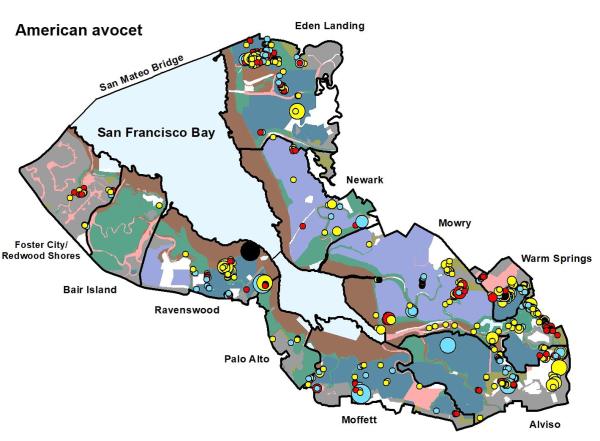Abstract
The South Bay Salt Pond Restoration Project aims to restore many former salt production ponds, now managed for wildlife and water quality, to tidal marsh. However, because managed ponds support large densities of breeding waterbirds, reduction of pond habitat may influence breeding waterbird distribution and abundance. We investigated habitat use associated with breeding, feeding, and roosting behaviors during the breeding season for American Avocets (Recurvirostra americana), Black-necked Stilts (Himantopus mexicanus), Forster’s Terns (Sterna forsteri), and Caspian Terns (Hydroprogne caspia) in south San Francisco Bay in 2019 after substantial tidal marsh restoration, and compared results to a 2001 survey (before restoration). In 2019, managed ponds (26% of currently available habitat) were selected by waterbirds engaged in breeding behaviors (> 39% of observations), foraging (> 42%), and roosting (> 73%). Waterbirds avoided tidal habitats (43% of available habitat), comprising < 17% of observations of breeding behavior, < 28% of foraging observations, and < 13% of roosting observations. Waterbird densities increased in managed ponds between 2001 and 2019, and decreased in active salt ponds, especially among feeding Avocets (92% decrease) and Stilts (100% decrease). Islands were important for waterbirds observed breeding and roosting (45% of Avocet and 53% of Tern observations). Avocets and Stilts fed primarily on wet bare ground (65% and 58%, respectively), whereas feeding Forster’s Terns and Caspian Terns used mostly open water (82% and 93%, respectively). Within ponds, Avocets were associated with islands (131 m closer than expected). Stilts and Forster’s Terns were also associated with islands (68 m and 161 m closer than expected), except when feeding (1 m closer and 90 m farther than expected). Avocets and Stilts were associated with pond levees (39 m and 41 m closer than expected), but Forster’s Terns were not (9 m closer than expected). Our results emphasize the importance of managed ponds for breeding and foraging waterbirds, including islands for breeding and roosting and levees for foraging.




